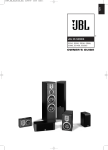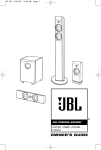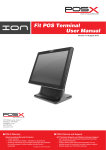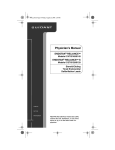Download JBL STUDIO™ SERIES Studio LC1
Transcript
® ™ STUDIO L SERIES L810, L820, L830, L880, L890, LC1, LC2 OWNER’S GUIDE SPEAKER PLACEMENT Proper placement of the speakers is an important step in obtaining the most realistic soundstage possible. These recommendations are for the optimum placement of the loudspeakers. Use these placement recommendations as a guide. Slight variations will not diminish your listening pleasure. All of the Studio L Series loudspeakers referred to in this guide are video-shielded and may safely be placed near a television. MODELS: L830, L880, L890 MODELS: L810 AND L830 As front speakers As surround speakers 1.5m–1.8m (5–6 ft.) 2 English MODEL: L820 The L820 loudspeakers are designed to be oriented horizontally, as shown in the illustrations below. Although these loudspeakers are designed as a mirrored pair, the decision as to which one is left or right will depend on the amount of space left between them. For stereo-only applications: A wider stereo image is presented with the tweeter/ midrange array outboard, and a tighter image is presented with the array inboard. Less than 1,8m-2,4m (6-8 feet) Less than 1,8m-2,4m (6-8 feet) For home theater applications: 0-0,6m (0-2ft) This placement provides a wide spread in sound, supplemented by the center channel speaker. MODELS: LC1, LC2 The LC1 and LC2 center channel loudspeakers are designed to complement all of the Studio L Series loudspeakers. Either speaker is ideal for re-creating the cinematic experience in your home. 3 SPEAKER CONNECTIONS MODELS: L810, L820, L830, L880, L890 Right Left RIGHT LEFT – + – – + – Right RIGHT Left LEFT + + Receiver’s Speaker Outputs MODELS: LC1, LC2 Center – + – + Center Receiver’s Speaker Outputs Speakers and electronics have corresponding (+) and (–) terminals. It is important to connect both speakers identically: (+) on the speaker to (+) on the amplifier and (–) on the speaker to (–) on the amplifier. Wiring “out of phase” results in thin sound, weak bass and poor imaging. To use the binding-post speaker terminals, unscrew the colored collar until the pass-through hole in the center post is visible. Insert the bare end of the wire through this hole; then screw the collar down until the connection is tight. The hole in the center of each collar is intended for use with banana-type connectors. To comply with European CE certification, these holes are blocked with plastic inserts at the point of manufacture. To use banana-type connectors requires the removal of the inserts. Do not remove these inserts if you are using the product in an area covered by the European CE certification. BI-WIRING The bi-wire connection method requires one amplifier and two sets of speaker wires. By removing the shorting bars, connections may be made to the individual network sections using four conductors, one for each of the four terminals. For single-wire connection, leave the shorting bars in place and connect only a single set of speaker wires (two conductors) to the two upper terminals. HighFrequency Frequency High – + – + Low Frequency – + Amplifier Amplifier Bi-Wire Connections SPEAKER SETUP MODELS: L810, L820, L830, LC1, LC2 The supplied self-adhesive rubber feet may be attached to the bottom corners of your speakers to protect your furniture. Placepads pads here Place here 4 MODELS: L880, L890 These models feature four rubber feet that enable them to be placed on a smoothsurfaced floor, such as tile or hardwood. Four metal spikes are supplied for use when the speaker is to be placed on a carpeted surface, to decouple the speaker from the floor and prevent unwanted damping. To insert the spikes, gently lay the speaker on its side (not its front or back) on a soft, nonabrasive surface. Each spike screws into the threaded insert in the center of each rubber foot. Make sure all four spikes are screwed in completely for stability. NEVER drag the speaker to move it, as this will damage the spikes, the feet and/or the wood cabinet itself. Always lift the speaker and carry it to its new location. positioned. If this is a concern, these speakers should be anchored to the wall behind them, using the same procedures and hardware customary for anchoring bookcases and wall units. The customer is responsible for proper installation and proper selection of hardware. WALL-MOUNTING (Models L810, L820, LC2) Important Safety Notes • Proper selection of mounting hardware and installation of the wall brackets are the responsibility of the customer. • This product is not intended for ceiling mounting. with your loudspeaker that indicates the proper locations for the pilot holes. In the event that the template is missing, refer to this chart: Model Distance Between Pilot Holes L810 152mm (6") L820 216mm (8-1/2") Two Number 8 round-head or pan-head screws should be used for each loudspeaker. The screw head should be between 5/16 inch (8mm) and 1/4 inch (6.3mm) in diameter, and the screw should be at least 2 inches (50mm) in length. LC2 368mm (14-1/2") When installing screws in any wall, it is always preferable to screw them into a wall stud. If none is available, it is important to always use properly selected wall anchors. Install the two screws into either a wooden wall stud or anchor, and tighten them until the back of each screw head is about 1/8" (3mm) from the wall. See Figure 2. Attach two of the four selfadhesive rubber pads that came with the loudspeaker to the back of the enclosure in the two bottom corners so that the cabinet is spaced evenly from the wall. Select a suitable mounting location on a wall. (The ceiling is not a suitable mounting location.) Drill two pilot holes, appropriately sized for the specific self-tapping screw or wall anchor that you will be using. A template is included See Figure 1. The holes should be 57mm below where you want the top of the enclosure to be positioned. Use a carpenter’s level to ensure that the holes are even and that the speaker will mount on the level. Models L810 and L820 may also be corner-mounted using the keyholes located on the bezeled corners. For corner mounting, fold the mounting template in half, place the fold in the corner at the desired height, and use the outer holes. In case the template is missing, for corner mounting drill each pilot hole 7-3/4" (197mm) from the corner for model L810, or 9-11/16" (246mm) from the corner for model L820. However, if your corner is not precisely 90 degrees, these measurements may not work. In that case, it is recommended that you contact a professional custom installer, who can determine the correct locations for the pilot holes. Install the loudspeaker by slowly moving the cabinet toward the screws so that the screw heads clear the larger circular portion of the two keyholes. Once both screw heads have entered the keyholes, the loudspeaker should gently be lowered onto the screw shafts. Check that the loudspeaker is firmly locked onto the screws by gently pulling the speaker down and forward. See Chart See Chart Fig. 1 3mm (1/8") Fig. 2 5 English CAUTION: Floorstanding (tower) loudspeakers have a high center of gravity and may become unstable and tip over during earthquakes, or if rocked, tipped or improperly SPECIFICATIONS L810 L820 L830 L880 Description 3-Way, 5-1/4" Bookshelf/ Wall-Mount Satellite 4-Way, 6" HighPerformance, Mirror-Image, Wall-Mount Satellite 3-Way, 6" Bookshelf 4-Way, Dual 6" Floorstanding Maximum Recommended Amplifier Power 150W 150W 150W 200W Power Handling (Continuous/Peak) 75W/300W 75W/300W 75W/300W 100W/400W Nominal Impedance 8 Ohms 8 Ohms 8 Ohms 8 Ohms Sensitivity (2.83V/1m) 88dB 90dB 90dB 91dB Frequency Response (±3dB) 60Hz – 40kHz 55Hz – 40kHz 48Hz – 40kHz 30Hz – 40kHz Crossover Frequencies 3500Hz, 20kHz 600Hz, 3500Hz, 20kHz 2500Hz, 20kHz 700Hz, 5000Hz, 20kHz Ultrahigh-Frequency Transducer 19mm (3/4") Mylar® Dome With Cast-Aluminum Chassis 19mm (3/4") Mylar® Dome 19mm (3/4") Mylar® Dome 19mm (3/4") Mylar® Dome With Cast-Aluminum Chassis With Cast-Aluminum Chassis With Cast-Aluminum Chassis High-Frequency Transducer 1" Pure-Titanium Dome With Cast-Aluminum Chassis in JBL EOS™ Waveguide 1" Pure-Titanium Dome With Cast-Aluminum Chassis in JBL EOS™ Waveguide 1" Pure-Titanium Dome With Cast-Aluminum Chassis in JBL EOS™ Waveguide 1" Pure-Titanium Dome With Cast-Aluminum Chassis in JBL EOS™ Waveguide Midrange Transducer N/A 4" PolyPlas™ Cone With Rubber Surround and Cast-Aluminum Chassis; HeatScape™ Motor Structure N/A 4" PolyPlas™ Cone With Rubber Surround and Cast-Aluminum Chassis; HeatScape™ Motor Structure Low-Frequency Transducer(s) 5-1/4" PolyPlas™ Cone With Rubber Surround and Cast-Aluminum Chassis; HeatScape™ Motor Structure; Symmetrical Field Geometry™ (SFG™); Oversized Kapton® Voice Coil; Magnetic Shorting Ring 6” PolyPlas™ Cone With Rubber Surround and Cast-Aluminum Chassis; HeatScape™ Motor Structure; Symmetrical Field Geometry™ (SFG™); Oversized Kapton® Voice Coil; Magnetic Shorting Ring 6" PolyPlas™ Cone With Rubber Surround and Cast-Aluminum Chassis; HeatScape™ Motor Structure; Symmetrical Field Geometry™ (SFG™); Oversized Kapton® Voice Coil; Magnetic Shorting Ring Dual 6" PolyPlas™ Cones With Rubber Surrounds and Cast-Aluminum Chassis; HeatScape™ Motor Structures; Symmetrical Field Geometry™ (SFG™); Oversized Kapton® Voice Coils; Magnetic Shorting Rings Magnetic Shielding Yes Yes Yes Yes Baffle Low Diffraction, IsoPower™ Low Diffraction, IsoPower™ Low Diffraction, IsoPower™ Low Diffraction, IsoPower™ Enclosure Bass-Reflex with Dual FreeFlow™ Front-Firing Ports Sealed Bass-Reflex with FreeFlow™ Rear-Firing Port Bass-Reflex with FreeFlow™ Front-Firing Port Network Straight-Line Signal Path™ (SSP) Straight-Line Signal Path™ (SSP) Straight-Line Signal Path™ (SSP) Straight-Line Signal Path™ (SSP) Terminals Gold-Plated 5-Way Binding Posts, Bi-Wirable Gold-Plated 5-Way Binding Posts, Bi-Wirable Gold-Plated 5-Way Binding Posts, Bi-Wirable Gold-Plated 5-Way Binding Posts, Bi-Wirable Dimensions (HxWxD) 362mm x 311mm x 127mm (14-1/4" x 12-1/4" x 5") 311mm x 391mm x 127mm (12-1/4" x 15-1/2" x 5") 385mm x 222mm x 320mm (15-1/4" x 8-3/4" x 12-3/4") 990mm x 222mm x 370mm (39" x 8-3/4" x 14-3/4") Weight per Speaker 14 lb (6.4kg) 19 lb (8.6kg) 22 lb (10kg) 54 lb (24.4kg) 6 LC1 LC2 4-Way, Dual 8" Floorstanding 3-Way, Dual 5-1/4" Center 4-Way, Dual 6" Wall-Mount Center Maximum Recommended Amplifier Power 250W 150W 150W Power Handling (Continuous/Peak) 125W/500W 75W/300W 75W/300W Nominal Impedance 8 Ohms 8 Ohms 8 Ohms Sensitivity (2.83V/1m) 91dB 91dB 92dB Frequency Response (±3dB) 28Hz – 40kHz 55Hz – 40kHz 50Hz – 40kHz Crossover Frequencies 700Hz, 5000Hz, 20kHz 3000Hz, 20kHz 700Hz, 4000Hz, 20kHz Ultrahigh-Frequency Transducer 19mm (3/4") Mylar® Dome With Cast-Aluminum Chassis 19mm (3/4") Mylar® Dome With Cast-Aluminum Chassis 19mm (3/4") Mylar® Dome With Cast-Aluminum Chassis High-Frequency Transducer 1" Pure-Titanium Dome With Cast-Aluminum Chassis in JBL EOS™ Waveguide 1" Pure-Titanium Dome With Cast-Aluminum Chassis in JBL EOS™ Waveguide 1" Pure-Titanium Dome With Cast-Aluminum Chassis in JBL EOS™ Waveguide Midrange Transducer 4" PolyPlas™ Cone With Rubber Surround and Cast-Aluminum Chassis; HeatScape™ Motor Structure N/A 4" PolyPlas™ Cone With Rubber Surround and Cast-Aluminum Chassis; HeatScape™ Motor Structure Low-Frequency Transducer(s) Dual 8" PolyPlas™ Cones With Rubber Surrounds and Cast-Aluminum Chassis; HeatScape™ Motor Structures; Symmetrical Field Geometry™ (SFG™); Oversized Kapton® Voice Coils; Magnetic Shorting Rings Dual 5-1/4" PolyPlas™ Cones With Rubber Surrounds and Cast-Aluminum Chassis; HeatScape™ Motor Structures; Symmetrical Field Geometry™ (SFG™); Oversized Kapton® Voice Coils; Magnetic Shorting Rings Dual 6" PolyPlas™ Cones With Rubber Surrounds and Cast-Aluminum Chassis; HeatScape™ Motor Structures; Symmetrical Field Geometry™ (SFG™); Oversized Kapton® Voice Coils; Magnetic Shorting Rings Magnetic Shielding Yes Yes Yes Baffle Low Diffraction, IsoPower™ Low Diffraction, IsoPower™ Low Diffraction, IsoPower™ Enclosure Bass-Reflex With FreeFlow™ Front-Firing Port Bass-Reflex With FreeFlow™ Rear-Firing Port Sealed Network Straight-Line Signal Path™ (SSP) Straight-Line Signal Path™ (SSP) Straight-Line Signal Path™ (SSP) Terminals Gold-Plated 5-Way Binding Posts, Bi-Wirable Gold-Plated 5-Way Binding Posts, Bi-Wirable Gold-Plated 5-Way Binding Posts, Bi-Wirable Dimensions (HxWxD) 1075mm x 259mm x 380mm (42-1/4" x 10-1/4" x 15") 191mm x 534mm x 254mm (7-1/2" x 21" x 10") 311mm x 559mm x 127mm (12-1/4" x 22" x 5") Weight per Speaker 27,5kg (60 lb) 10.5kg (23 lb) 13,2kg (29 lb) English L890 Description 7 TROUBLESHOOTING If there is no sound from any of the speakers: • Check that receiver/amplifier is on and that a source is playing. • Review proper operation of your receiver/amplifier. If there is no sound coming from one speaker: • Check the “Balance” control on your receiver/ amplifier. • Check all wires and connections between receiver/ amplifier and speakers. • Make sure no wires are touching other wires or terminals and creating a short circuit. • Make sure all wires are connected. Make sure none of the speaker wires are frayed, cut or punctured. • In Dolby* Digital or DTS® modes, make sure that the receiver/processor is configured so that the speaker in question is enabled. • Turn off all electronics and switch the speaker in question with one of the other speakers that is working correctly. Turn everything back on, and determine whether the problem has followed the speakers, or has remained in the same channel. If the problem is in the same channel, the source of the problem is most likely with your receiver or amplifier, and you should consult the owner’s manual for that product for further information. If the problem has followed the speaker, consult your dealer for further assistance or, if that is not possible, visit www.jbl.com for further information. If the system plays at low volumes but shuts off as volume is increased: • Check all wires and connections between receiver/ amplifier and speakers. If there is no sound from the surround speakers: • Check all wires and connections between receiver/ amplifier and speakers. Make sure all wires are connected. Make sure none of the speaker wires are frayed, cut, punctured or touching each other. • Review proper operation of your receiver/amplifier and its surround sound features. • Make sure all wires are connected. Make sure none of the speaker wires are frayed, cut or punctured. • Make sure the movie or TV show you are watching is recorded in a surround sound mode. If it is not, check to see whether your receiver/ amplifier has other surround modes you may use. • If more than one pair of main speakers is being used, check the minimum impedance requirements of your receiver/amplifier. • In Dolby Digital or DTS modes, make sure your receiver/ processor is configured so that the surround speakers are enabled. If there is no (or low) bass output: • Review the operation of your DVD player and the jacket of your DVD to make sure that the DVD features the desired Dolby Digital or DTS mode, and that you have properly selected that mode using both the DVD player’s menu and the DVD disc’s menu. • Make sure the polarities (+ and –) of the left and right “Speaker Inputs” are connected properly. • Consider adding a powered subwoofer to your system for use with digital “.1” surround formats. Declaration of Conformity We, Harman Consumer Group International 2, route de Tours 72500 Chateau-du-Loir France declare in own responsibility that the products described in this owner’s manual are in compliance with technical standards: EN 61000-6-3:2001 EN 61000-6-1:2001 Laurent Rault Harman Consumer Group International Chateau-du-Loir, France 4/05 PRO SOUND COMES HOME™ JBL Consumer Products, 250 Crossways Park Drive, Woodbury, NY 11797 USA 8500 Balboa Boulevard, Northridge, CA 91329 USA, phone 516-255-4JBL (USA only) 2, route de Tours, 72500 Chateau-du-Loir, France www.jbl.com © 2005 Harman International Industries, Incorporated. All rights reserved. JBL is a registered trademark of Harman International Industries, Incorporated. Part No.353334-001 * Trademarks of Dolby Laboratories. DTS is a registered trademark of Digital Theater Systems, Inc. Mylar and Kapton are registered trademark of E.I. du Pont de Nemours and Company. ** The maximum recommended amplifier power rating will ensure proper system headroom to allow for occasional peaks. We do not recommend sustained operation at these maximum power levels. All features and specifications are subject to change without notice. All dimensions include grilles and feet, but not spikes.























